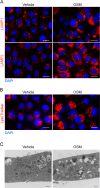Methods for investigating STAT3 regulation of lysosomal function in mammary epithelial cells
- PMID: 38761238
- PMCID: PMC11102350
- DOI: 10.1007/s10911-024-09563-3
Methods for investigating STAT3 regulation of lysosomal function in mammary epithelial cells
Abstract
The transcription factor STAT3 is activated by multiple cytokines and other extrinsic factors. It plays a key role in immune and inflammatory responses and, when dysregulated, in tumourigenesis. STAT3 is also an indispensable mediator of the cell death process that occurs during post-lactational regression of the mammary gland, one of the most dramatic examples of physiological cell death in adult mammals. During this involution of the gland, STAT3 powerfully enhances the lysosomal system to efficiently remove superfluous milk-producing mammary epithelial cells via a lysosomal-mediated programmed cell death pathway. The lysosome is a membrane-enclosed cytoplasmic organelle that digests and recycles cellular waste, with an important role as a signalling centre that monitors cellular metabolism. Here, we describe key strategies for investigating the role of STAT3 in regulating lysosomal function using a mammary epithelial cell culture model system. These include protocols for lysosome enrichment and enzyme activity assays, in addition to microscopic analyses of the vesicular compartment in cell lines. Collectively, these approaches provide the tools to investigate multiple aspects of lysosome biogenesis and function, and to define both direct and indirect roles for STAT3.
Keywords: Cell death; Lysoptosis; Lysosome; Lysosome-mediated programmed cell death; Mammary gland; STAT3 signalling.
© 2024. The Author(s).
Conflict of interest statement
B.L-L. and C.J.W. are members of this journal's Editorial Board.
Figures




Similar articles
-
Stat3-mediated alterations in lysosomal membrane protein composition.J Biol Chem. 2018 Mar 23;293(12):4244-4261. doi: 10.1074/jbc.RA118.001777. Epub 2018 Jan 17. J Biol Chem. 2018. PMID: 29343516 Free PMC article.
-
ZnT2 is critical for lysosome acidification and biogenesis during mammary gland involution.Am J Physiol Regul Integr Comp Physiol. 2018 Aug 1;315(2):R323-R335. doi: 10.1152/ajpregu.00444.2017. Epub 2018 May 2. Am J Physiol Regul Integr Comp Physiol. 2018. PMID: 29718697 Free PMC article.
-
The Multifaceted Role of STAT3 in Mammary Gland Involution and Breast Cancer.Int J Mol Sci. 2018 Jun 7;19(6):1695. doi: 10.3390/ijms19061695. Int J Mol Sci. 2018. PMID: 29875329 Free PMC article. Review.
-
Stat3 controls cell death during mammary gland involution by regulating uptake of milk fat globules and lysosomal membrane permeabilization.Nat Cell Biol. 2014 Nov;16(11):1057-1068. doi: 10.1038/ncb3043. Epub 2014 Oct 5. Nat Cell Biol. 2014. PMID: 25283994 Free PMC article.
-
Alveolar cells in the mammary gland: lineage commitment and cell death.Biochem J. 2022 May 13;479(9):995-1006. doi: 10.1042/BCJ20210734. Biochem J. 2022. PMID: 35551601 Free PMC article. Review.
Cited by
-
Methods and Models in Mammary Gland Biology and Breast Cancer Research.J Mammary Gland Biol Neoplasia. 2025 Mar 8;30(1):4. doi: 10.1007/s10911-025-09579-3. J Mammary Gland Biol Neoplasia. 2025. PMID: 40055275 Free PMC article.
References
MeSH terms
Grants and funding
LinkOut - more resources
Full Text Sources
Research Materials
Miscellaneous

